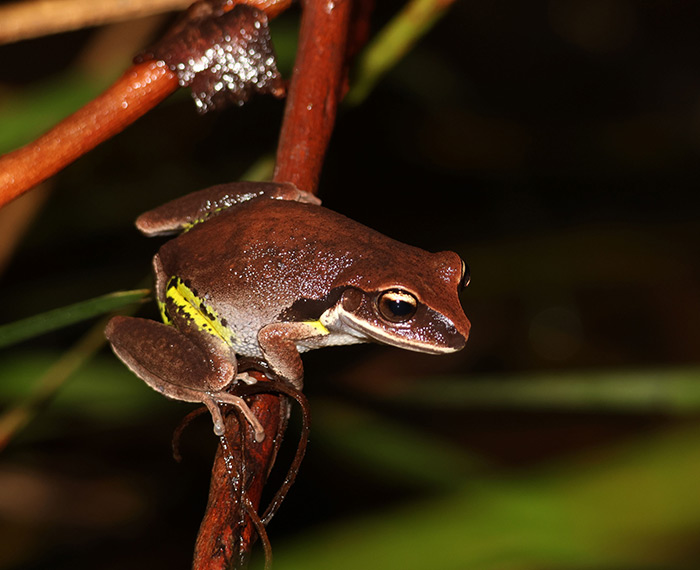Plant and wildlife surveys highlight Scenic Rim's biodiversity

The green-thighed frog is among a number of species which have been doing well in recent years as man-made dams on Land for Wildlife properties in the Scenic Rim have provided important breeding habitats for fragile native frogs. Photo Greg Tasney.
The potential discovery of a new plant species and the important role of private property owners in maintaining the Scenic Rim's biodiversity were highlighted in recent surveys through Council's Land for Wildlife program.
Property owners at Coochin had long suspected that there was something special about a species of nightshade growing on their land and further investigation by an expert from the Queensland Herbarium and careful examination of local records in coming months may see an addition to the Scenic Rim's roll of unique species.
"The discovery of a new species is always exciting but finding a new native plant species in Southeast Queensland is particularly unique because so much ground has been explored in the past by many knowledgeable botanists," environmental consultant Greg Tasney said.
"It also highlights the important role of landowners not only in providing the environment for native plants and animals to flourish but also identifying new species."
While the Scenic Rim is one of the most biodiverse regions in Australia, the survey of a single 65-hectare property at Palen Creek revealed 300 plant species alone, within ecosystems including creeks, dry gullies, open forest, native grassland, pasture paddocks and a rhyolite ridge.
It was jingle all the way at a 19-hectare property near Mount Barney, where four species of Christmas beetle were found. This was particularly good news as, across Southeast Queensland, Christmas beetle numbers have been falling due to loss of grassy woodland.
More than 500 species of plants and animals were found across multiple ecosystems on the same Mount Barney property which is providing valuable habitat for Christmas beetles.
As another barometer of the health of the environment, healthy frog populations were surveyed on 650 hectares of land at Carneys Creek which are covered by Land for Wildlife, Nature Refuge and Voluntary Conservation Agreements.
Nine species of frog, including the Cryptic Dusky Gungun, were found in three dams while only two species were found at a creek crossing.
"This tells us that that man-made dams on Land for Wildlife properties are very important breeding habitats for many species of our fragile native frogs," Mr Tasney said.
"The small to medium-sized dams surveyed had native aquatic and semi-aquatic plants well established around the edges and it is likely that the frogs choose to breed in dams as they provide protection from drying out, fast-flowing water and predators like fish."
Land for Wildlife is a voluntary program offered by Scenic Rim Regional Council to encourage and assist landholders to provide habitat for wildlife on their properties. This free program provides valuable services including expert advice, technical assistance and funding, when available, for environmental works.
To be eligible for the Land for Wildlife program, landholders must have at least one hectare of land with native vegetation and be interested in integrating nature conservation with other land uses, such as agriculture, grazing or tourism.
Those wishing to join the program are encouraged to phone Council on 5540 5111 to arrange an appointment with a Land for Wildlife officer.
